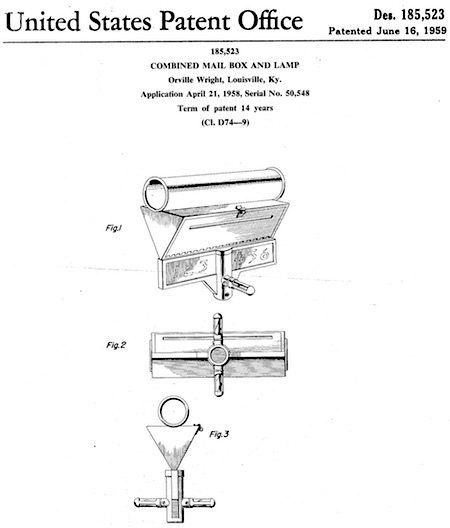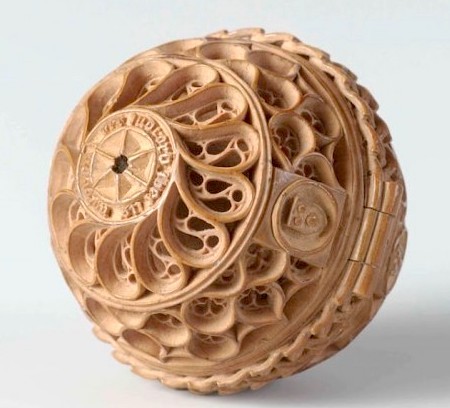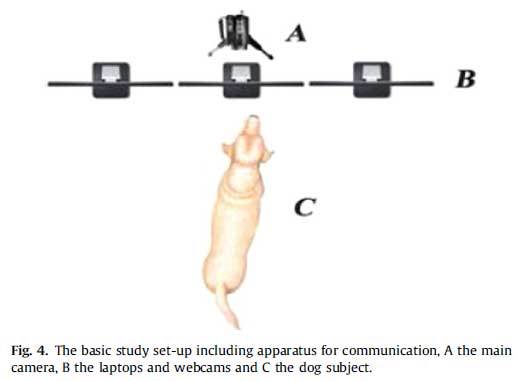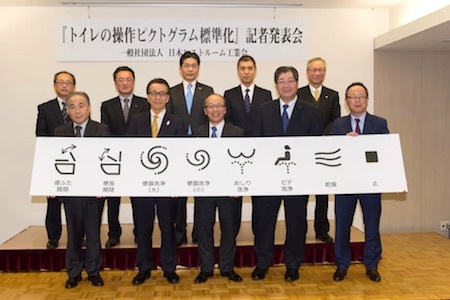Marc Abrahams's Blog, page 231
January 23, 2017
Face Recognition of Cattle: Can it be Done?
“Contrary to popular belief that all cattle look alike, this paper presents a current state of the art research and study in animal biometric based recognition a system which provides an important insight in the identification of cattle based on their facial images.”
– so explain researchers Santosh Kumar, Shrikant Tiwari, and Sanjay Kumar Singh of the Department of Computer Engineering, Indian Institute of Technology (BHU), and the Department of Computer Science and Engineering, Faculty of Engineering and Technology, Shri Shankaracharya Group of Institution, Shri Shankaracharya Technical Campus, Junwani, District-Durg, Bhilai, Chattisgarh, India, in a new paper for the journal Proceedings of the National Academy of Sciences, India Section A: Physical Sciences, June 2016, Volume 86, Issue 2, pp 137–148. It’s entitled ‘Face Recognition of Cattle: Can it be Done?’
The team created an image database of 3000 images (300 subjects each with 10 photos) and tested several different computerised methodologies, leading to an answer for their question which, broadly speaking, is ‘Yes’.
“The appearance (holistic) based face recognition approaches, independent component analysis (ICA) [36–38] algorithm yield the recognition accuracy of 86.95 % at the starting level of Gaussian smoothing. The PCA-LiBSVM [17–19, 32, 33, 41, 43] and ICA-LiBSVM [36–38, 41, 43] face recognition approaches provide the recognition accuracy of 95.62 and 95.87 % respectively.”
COMING SOON Other methods of computerized cow recognition that can also be done.
BONUS (facial recog. related): The privacy goggles of Prof. Echizen

January 22, 2017
Q: what, exactly, did Orville Wright invent? A: a mailbox
Many people associate the name Orville Wright with the invention of the airplane.
However, Orville Wright invented — and patented — a combined mailbox and lamp:

January 21, 2017
Was the prayer nut filled with gunk?
“The prayer nut” is the subject of this video, which zeroes in on the question: Was the prayer nut filled with some kind of gunk? Research, careful research, hints that it may indeed have been filled with gunk, and that that gunk may have included fragrant herbs, one of which may have been cannabis.
The maker of the video tells what the prayer nut is. The prayer nut is, in this telling, “a microscopically carved medieval devotional.” The scientist in the video, he who probes the innards of the prayer nut, is Joris Dik.
This is not the only prayer nut. You can visit a prayer nut in The British Museum, in London. You can purchase prayer nuts. You can make prayer nuts, if you have the desire, the time, and perhaps the talent.
Really, there are few limits to what you can do with regard to a prayer nut.

January 20, 2017
The prize-winning lecture about recognizing bullshit
The 2016 Ig Nobel Peace Prize winners explain about people’s craving for bullshit, in their Ig Informal Lecture, as you see in this video:
The prize was awarded to Gordon Pennycook, James Allan Cheyne, Nathaniel Barr, Derek Koehler, and Jonathan Fugelsang for their scholarly study called “On the Reception and Detection of Pseudo-Profound Bullshit”.
The details of that study: “On the Reception and Detection of Pseudo-Profound Bullshit,” Gordon Pennycook, James Allan Cheyne, Nathaniel Barr, Derek J. Koehler, and Jonathan A. Fugelsang, Judgment and Decision Making, vol. 10, No. 6, November 2015, pp. 549–563.
Two days after the ceremony, at the Ig Informal Lectures, the new winners give brief public talks, at MIT, to explain what they did and why they did it. That’s what you see in this video.

January 19, 2017
January issue of mini-AIR
 The January issue of mini-AIR just went out. (mini-AIR is a wee little supplement to the magnificent magazine Annals of Improbable Research.) Topics include:
The January issue of mini-AIR just went out. (mini-AIR is a wee little supplement to the magnificent magazine Annals of Improbable Research.) Topics include:
The P-p-p-p-Power of the Words, Words, Words
News about the upcoming events in NYC, Boston, and Europe
“PPP versus PPPP — What is Wrong in Denmark?”
and more
It also has info about upcoming events. And events that are upcoming.
Mel [pictured here] says, “It’s swell.”
mini-AIR is the simplest way to keep informed about Improbable and Ig Nobel news and events.
Want mini-AIR e-mailed to you every month? Just opt in!

Is your dog watching TV?
 If you’d like to scientifically determine whether your dog (or any other dog) is watching TV, you could try using a high-quality method of face tracking (from a Human Computer Interaction [HCI] standpoint) as suggested by PhD researcher Ilyena Hirskyj-Douglas and Prof. Janet C Read from the Animal Computer Interaction Design (ACID), a research group at the University of Central Lancashire (UCLan), UK. They have noted that :
If you’d like to scientifically determine whether your dog (or any other dog) is watching TV, you could try using a high-quality method of face tracking (from a Human Computer Interaction [HCI] standpoint) as suggested by PhD researcher Ilyena Hirskyj-Douglas and Prof. Janet C Read from the Animal Computer Interaction Design (ACID), a research group at the University of Central Lancashire (UCLan), UK. They have noted that :
“Dogs have continually been reported to view television screens but there is diminutive knowledge behind this phenomenon.“
Their line of enquiry :
“[…] brings forward the possibility of animals having meaningful interaction with the TV screen and suggests ways to possibly quantify and build methods to create animal-computer-interaction.”
see: ‘Is My Dog Watching TV?’ (NordiCHI’14. Animal Computer Interaction Workshop, 2014)
Since then however, new work by the team (along with Dr. Brendan Cassidy) found that when dogs are presented with a choice of more than one screen (specifically 3), things are considerably less clear :
“ The findings provide evidence that when dogs are presented with three screens they are unable to follow through three screen variations on what to watch. There is a possibility that a central placement is the preference. On average the dogs had a low mean view time per interaction and seemed content to glance across the multiple screens. Overall, even though the content subject within the videos was different and proved to be appealing to the dogs, the dogs, when confronted with three screen options, preferred to watch nothing.”
“The dogs in this study chose to not watch TV over any TV content; even Coronation Street failed to hold their attention which rather suggests that TV watching, for dogs, maybe much less fun than wandering around, eating, taking a drink, sleeping and playing with toys.” [our hyperlink]
See: A dog centred approach to the analysis of dogs’ interactions with media on TV screens – awaiting publication in the International Journal of Human-Computer Studies.
BONUS[1]: Those wishing to further examine the world of Dog-TV Interaction may explore the output of “The First TV Channel For Dogs” DOGTV.
BONUS[2]: Andrew Dost (of the indie rock band Fun) composes music for dogs (ABC report)
COMING SOON: Cow-Computer Interaction

January 18, 2017
“Japanese toilet industry agrees to standardize complex bidet controls”
User interface issues are not glamorous — but they do matter. Many irksome problems linger for years or decades. Sam Byford reports, in The Verge, on a cleansing case:
Japanese toilet industry agrees to standardize complex bidet controls
The Japan Sanitary Equipment Industry Association, a consortium of companies producing plumbing products including Toto, Panasonic, and Toshiba, has agreed to unify the iconography used on the often baffling control panels for Japanese toilets. The decision was made in response to foreign tourists who say they’re often unable to understand the controls, which operate features often not found on Western toilets such as bidets and warm air drying….

Using Voodoo Dolls to Measure Aggression in Married Couples (podcast #98)
Are voodoo dolls and low blood sugar helpful for understanding why married couples squabble? A research study explores that very question, and we explore that study, in this week’s Improbable Research podcast.
SUBSCRIBE on Play.it, iTunes, or Spotify to get a new episode every week, free.
This week, Marc Abrahams discusses a published voodoo-doll-utilizing study (the very study that made the word “hangry” fairly famous). Tufts University biomedical researcher Dany Adams lends her voice, and her scientific expertise, and her opinions —with dramatic readings from a research study you may have overlooked.
For more info about what we discuss this week, go explore:
“Low glucose relates to greater aggression in married couples,” by Brad J. Bushman, C. Nathan DeWall, Richard S. Pond, Jr., and Michael Hanus, Proceedings of the National Academy of Sciences, vol. 111, no. 17, 2014, pp. 6254-6257.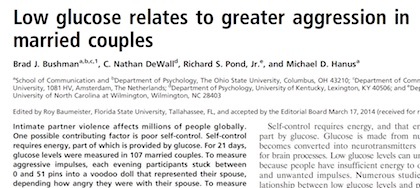
Brad Bushman shared the 2013 Ig Nobel Prize for psychology.
The mysterious John Schedler or the shadowy Bruce Petschek perhaps did the sound engineering this week.
The Improbable Research podcast is all about research that makes people LAUGH, then THINK — real research, about anything and everything, from everywhere —research that may be good or bad, important or trivial, valuable or worthless. CBS distributes it, on the CBS Play.it web site, and on iTunes and Spotify).

False Steps: Activity Monitors’ Mistakes
Washing and drying dishes may not be quite the same thing as taking steps with your legs — but to some machines, sometimes it is. A step-by-step investigation suggests that the electromechanical fitness trackers, which track how many steps people take, can vary considerably in what they count as a step. Details are in this report:
“When a Step Is Not a Step! Specificity Analysis of Five Physical Activity Monitors,” Sandra O’Connell, Gearóid Ó Laighin, and Leo R. Quinlan, PLoS ONE, vol. 12, no. 1, 2017: e0169616.
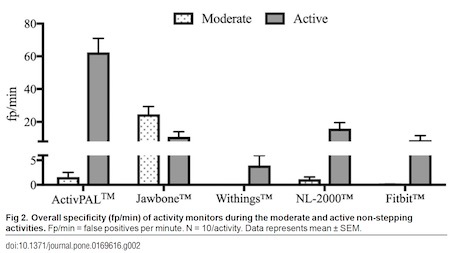
The authors, at NUI Galway, Ireland, write:
As step count is one of the most utilized measures for quantifying physical activity it is important that activity-monitoring devices be both sensitive and specific in recording actual steps taken and disregard non-stepping body movements. The objective of this study was to assess the specificity of five activity monitors during a variety of prescribed non-stepping activities. …
Methods — Participants wore five activity monitors simultaneously for a variety of prescribed activities including deskwork, taking an elevator, taking a bus journey, automobile driving, washing and drying dishes; functional reaching task; indoor cycling; outdoor cycling; and indoor rowing. Each task was carried out for either a specific duration of time or over a specific distance. Activity monitors tested were the ActivPAL micro™, NL-2000™ pedometer, Withings Smart Activity Monitor Tracker (Pulse O2)™, Fitbit One™ and Jawbone UP™. Participants were video-recorded while carrying out the prescribed activities and the false positive step count registered on each activity monitor was obtained and compared to the video.
Results — All activity monitors registered a significant number of false positive steps per minute… The Withings™ activity performed best, registering a significant number of false positive steps per minute during the outdoor cycling activity only. The Jawbone™ registered a significant number of false positive steps during the functional reaching task and while washing and drying dishes.
(Thanks to Neil Martin for bringing this to our attention.)
BONUS (possibly related): Martha Stewart’s step-by-step advice for how to wash dishes.

January 16, 2017
The Lure of Horse-Computer Interaction : an ethographic approach
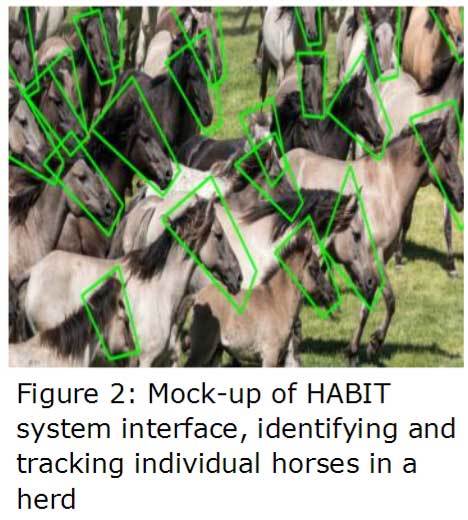 Dr Steve North and colleagues at the University of Nottingham, UK have developed a new study-area methodology, and have coined a new word for it : “Ethographology“ (derived from ‘ethnographic’ and ‘ethology’).
Dr Steve North and colleagues at the University of Nottingham, UK have developed a new study-area methodology, and have coined a new word for it : “Ethographology“ (derived from ‘ethnographic’ and ‘ethology’).
“The ethnographic elements of ethographology describe practices, reasons, cultures, and competencies. By way of contrast, the ethology components of ethographology are more concerned with behaviors, purposes, species, and strategies. Some advantages to ethographology as a methodology are: allowing narratives to be compared, reducing observer bias, and generalization of results across studies.”
Details can be found in Dr North’s paper ‘Do androids dream of electric steeds? The allure of horse-computer interaction.’ ACM Interactions, 23 (2). pp. 50-53. 2016.
More information on Horse-Computer Interaction can be examined in ‘HABIT: Horse Automated Behaviour Identification Tool – A Position Paper’ (from which the photo above is taken)
Coming soon : Dog-Multiscreen Interaction

Marc Abrahams's Blog
- Marc Abrahams's profile
- 14 followers



